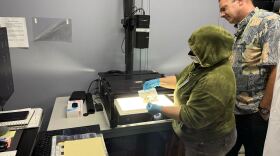Kahakai Park in the Hawaiian Beaches Subdivision of Puna on Hawaiʻi Island now goes by a new name — Waiakahiʻula.
The name change honors the original place name and the rich cultural history of the area.
Waiakahiʻula means "the place where the water runs red." Fishermen of the area say the cascading streams along the area's cliffs take on a reddish hue during hoʻoilo or the wet season from November to April.
After more than a year of lobbying by Pāhoa High School teachers Leah Gouker and Noʻeau Woo-O’Brien, Hawaiʻi County made the official change from Kahakai Park to Waiakahiʻula Park.

The park contains remnants of an old Hawaiian village of Waiakahiʻula, including a well-preserved canoe shed, foundations of a house and various agricultural sites.
Students from the school's ʻAha Lamakū ʻOiaʻiʻo program compiled historical information about Waiakahiʻula, including one story told by Kalapana kupuna the late Aunty Minnie Kaʻawaloa.
In the late 1700s, the people of Waiakahiʻula rebelled against their oppressive chief ʻAhia, who sought to overtax his people. During the battle, the makaʻāinana invoked the rains of Puna and a torrential rainstorm carried the fallen bodies of ʻAhia’s men toward the ocean.
The coastal area of Waiakahiʻula became the final resting place for many iwi kūpuna.
Hawaiʻi County will be using the students’ research to create interpretive signage for the park.




